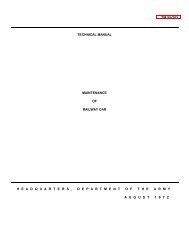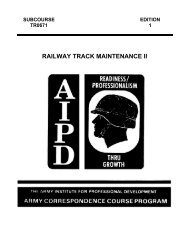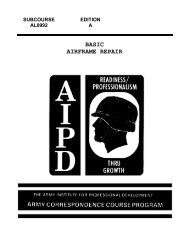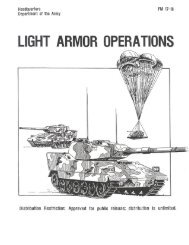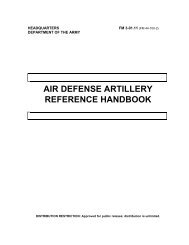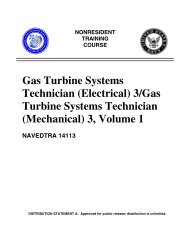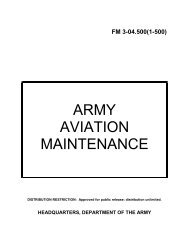fm 44-100 us army air and missile defense operations
fm 44-100 us army air and missile defense operations
fm 44-100 us army air and missile defense operations
Create successful ePaper yourself
Turn your PDF publications into a flip-book with our unique Google optimized e-Paper software.
AIR DEFENSE ESTIMATE NUMBER____<br />
References: Maps, charts, or other documents.<br />
Time Zone Used Throughout the Estimate:<br />
1. MISSION<br />
ESTIMATE OF THE AIR DEFENSE SITUATION<br />
(Classification)<br />
Headquarters<br />
Place<br />
Date, time, <strong>and</strong> zone<br />
Message reference number<br />
FM <strong>44</strong>-<strong>100</strong><br />
When the estimate's purpose is to support the force level comm<strong>and</strong>er's operation, <strong>us</strong>e the force level comm<strong>and</strong>er's<br />
mission statement. As the comm<strong>and</strong>er or <strong>operations</strong> officer, <strong>us</strong>e the unit's mission statement when the estimate's<br />
purpose is to determine which course of action best accomplishes the support mission.<br />
2. SITUATION AND CONSIDERATIONS<br />
This paragraph describes the conditions under which the unit will perform its mission <strong>and</strong> the possible courses of action<br />
of the supported force.<br />
(a) Characteristics of area of operation. For this paragraph, determine those factors of the situation which<br />
influence friendly <strong>and</strong> threat actions <strong>and</strong> which, therefore, may influence the choice of a course of action. In the absence<br />
of facts, <strong>us</strong>e logical assumptions that might directly affect the mission. Includes analysis of the effects of pertinent<br />
characteristics on conducting <strong>air</strong> <strong>and</strong> <strong>missile</strong> <strong>defense</strong> <strong>operations</strong><br />
1. Weather. Put the analysis of data from predicted weather <strong>and</strong> light conditions for the period in this<br />
paragraph. Assess how the weather affects friendly <strong>operations</strong>. Also include the evaluation of how weather <strong>and</strong> light<br />
conditions might affect the <strong>us</strong>e of threat UAVs; <strong>missile</strong>s; <strong>air</strong>craft, both fixed <strong>and</strong> rotary-wing; <strong>and</strong> <strong>air</strong>borne or <strong>air</strong> assault<br />
<strong>operations</strong>. Try to determine or predict when the threat will probably <strong>us</strong>e those assets due to the weather.<br />
2. Terrain. Analyze the effects of terrain, including effects on observation <strong>and</strong> fire; cover <strong>and</strong> concealment;<br />
movement (surface <strong>and</strong> <strong>air</strong>); employment of friendly <strong>and</strong> threat NBC weapons; communications, electronic warfare <strong>and</strong><br />
combat surveillance; unconventional warfare; psychological <strong>operations</strong>; <strong>and</strong> other aspects of military <strong>operations</strong>.<br />
Determine key terrain <strong>and</strong> <strong>air</strong> avenues of approach. Also disc<strong>us</strong>s terrain features that limit <strong>air</strong> vehicle detection or target<br />
acquisition <strong>and</strong> terrain that might canalize or force <strong>air</strong> targets to fly a particular profile. Try to determine where the threat<br />
will most probably <strong>us</strong>e <strong>air</strong> assets.<br />
3. Other pertinent factors. List analysis of political, economic, sociological, psychological, <strong>and</strong> other factors<br />
(such as hydrography, environment, communications, science, technology, materiel, transportation, safety <strong>and</strong> accident<br />
prevention, <strong>and</strong> manpower). Include deduction about their effects on friendly <strong>and</strong> threat <strong>operations</strong>.<br />
(b) Threat Forces. A threat evaluation disc<strong>us</strong>ses threat capabilities that are or may be a threat to the operation.<br />
1. Disposition. List locations of threat forces that will participate in <strong>air</strong> or <strong>missile</strong> <strong>operations</strong> or that threaten<br />
friendly <strong>air</strong> <strong>and</strong> <strong>missile</strong> <strong>defense</strong> <strong>operations</strong>. Determine combinations of <strong>air</strong> platforms that the threat may <strong>us</strong>e when<br />
conducting a particular type of operation.<br />
2. Composition. The threat organization for combat includes identity of units, types of <strong>air</strong> platforms <strong>and</strong><br />
<strong>missile</strong>s, <strong>and</strong> armament. Also address how many sorties <strong>and</strong> <strong>missile</strong>s are expected to be flown per day, <strong>and</strong><br />
possible composition of those sorties.<br />
Figure B-1. AD Estimate General Format<br />
B-3




